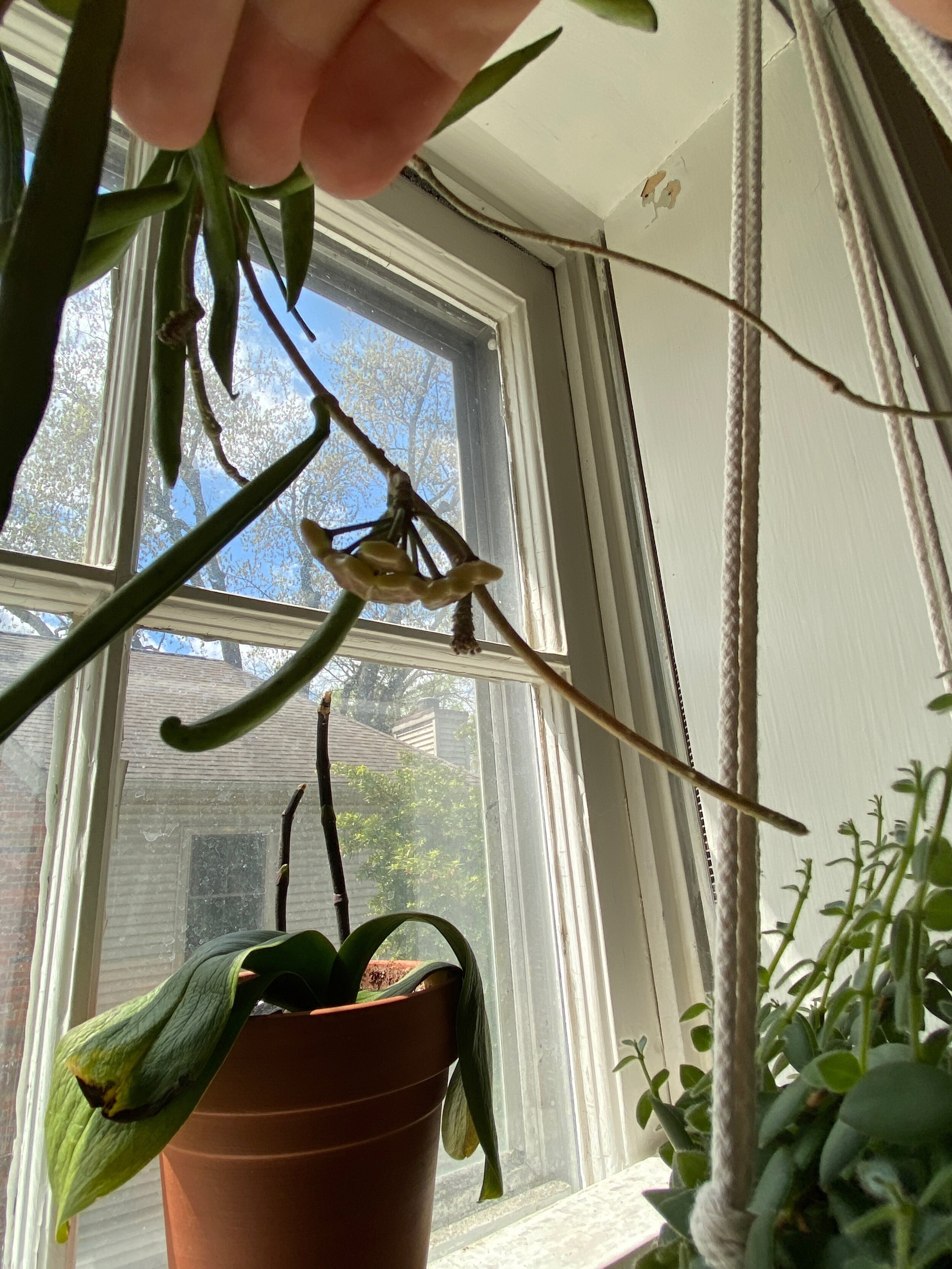Hoya Longifolia In Bloom. (Updated)
It wasn’t that long ago that I learned that Hoya Shepherdii is a synonym for Hoya Longifolia. I coveted one of these plants, also known as “Green Bean Hoya,” or “String Bean Hoya.” I love the way the long slender leaves look hanging over a pot, and I was impressed by just how waxy the plant feels. It’s such a unique Hoya, not the every day “look” you see in a houseplant, though not exactly rare by any means. I’m not even sure what “rare” means anymore since nearly every plant is endowed with that title by sellers at some point. This Hoya wasn’t hard to find, which isn’t a surprise to me. I actually found three. I later combined two smaller plants into one pot and repotted the third into my favorite pot for Hoya, a shallow terra-cotta Azalea pot.
As you can see, the top plant, which is a combination of the two smaller H. Longifolia, came with several peduncles, or bloom spurs. I wasn’t expecting much out of these. In fact, I expected the plant to drop them because I had it shipped across the country last fall. I was sure the plant would show its protest and stress by dropping whatever it saw fit, starting with the bloom spurs. Much to my surprise and delight, the plant kept it’s…well, everything. I originally placed this plant near the South window where many of my Hoya live. For some reason, it wasn’t feeling right and I made the decision to switch it into my lucky blooming window, a second story West window with a slight draft. I don’t know why, but this window keeps a Lipstick plant quite content, and two Orchids blooming the entire year. I have often heard that Hoya and Orchids have a lot in common. Both are Epiphytes, though that isn’t saying much. In my experience and in my environment, it takes similar nutrients (soil and fertilizer, in particular) and care to bloom a Hoya and an Orchid. So, I put my combo Longifolia there and I went about my business. The light there can be intense, and I gauged by the thickness of the leaves and the woody vines that Longifolia would be fine and hopefully even bloom in a spot that some finer leaved Hoya (like my unidentified thin leafed bloomer) would wilt and wither. And then it happened. It did start to bloom!
It’s been almost a month and it’s still continuing to bloom on various spurs. It’s producing more bloom spurs all the time. I wasn’t expecting this plant, like I said, to bloom at all, let alone bloom on multiple peduncles. I’m really surprised by what an enjoyable stress-free plant this has turned out to be.
My other, much larger Hoya Longifolia is not in bloom and it does not have any peduncles that I have seen. I think there are a couple of reasons why the smaller plant has been such a bloomer and the larger plant hasn’t. First, the smaller plant came with peduncles when it arrived in my home. It is clearly a mature plant. The larger plant has size, but it doesn’t have maturity. The vines have not yet achieved a woody texture and it looks apparent to me that this plant was propagated not too long before I bought it. The smaller plant is clearly ahead the larger one when it comes to blooming potential. However, if it wasn’t in the right light, I don’t think it would have mattered. It likely wouldn’t have bloomed without that West window. The larger plant is in a shady nook near a south window, but it’s protected from the quality and quantity of sun that its smaller counterpart now enjoys.
I think maturity is something that bears consideration to all of us Hoya lovers who might wonder what we are doing wrong if our “easy” Hoya just aren’t blooming. Many of the plants in the big box stores and even local nurseries are mass produced and propagated not long before they come into our homes. They’re coming sometimes from hardware stores where they’re living in bizarre conditions to say the least. The plant will seek to develop a mature root system before it grows long vines or even thinks about blooming. This is just another reason why it’s a good idea to keep a Hoya root-bound in a pot. It isn’t just a “trick” to get the Hoya to bloom, it’s comfortable for the plant, at least up to a certain point. Hoya are known for their preference for living many years in the same pot without the need for repotting, so chances are it wouldn’t appreciate a roomier pot. Light is another consideration. This tale of two Hoya got me thinking more about light as a whole.
UPDATE 6/21/20:
The blooms have really taken off on a whole new level. For the last few nights, the scent of Hoya Longifolia blooms fills the second floor of my house. I find the scent to be very floral, no chocolate citrus as I’ve heard from others.




















